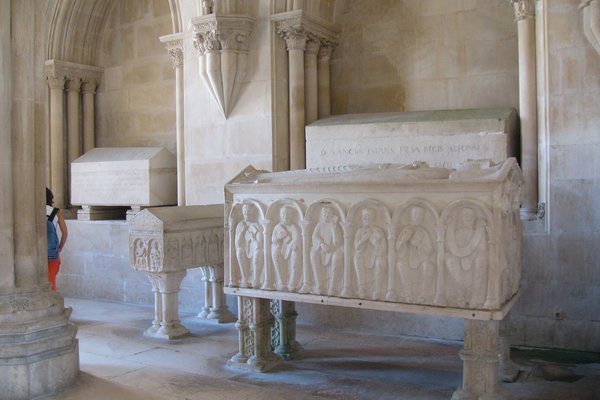Portugal
Monastery of Alcobaça
The Monastery of Alcobaça is a unique monastic establishment and a masterpiece of Gothic Cistercian art.
The monastery was founded by the first Portuguese King, Afonso Henriques, and maintained a close association with the Kings of Portugal throughout its history as it includes the Royal Tombs and the Royal Pantheon. The church and monastery were the first truly Gothic buildings in Portugal. Of further note is its 18th-century kitchen, where a hydraulic system brought water and fresh fish from the river Alcoa.
Community Perspective: overall characterized by a simple elegance, the best sights include the tombs of Inês de Castro and Dom Pedro, the Cloister of Silence, the refectory and the kitchen.
Site Info
Official Information
- Full Name
- Monastery of Alcobaça (ID: 505)
- Country
- Portugal
- Status
-
Inscribed 1989
Site history
History of Monastery of Alcobaça
- 1989: Inscribed
- Inscribed
- Type
- Cultural
- Criteria
- i
- iv
Links
- UNESCO
- whc.unesco.org
- Official
-
- mosteiroalcobaca.pt — Mosteiro de Alcobaça
- Related
-
- manorhouses.com — Mosteiro de Alcobaça
All Links
UNESCO.org
- whc.unesco.org — whc.unesco.org/
Official Website
- mosteiroalcobaca.pt — Mosteiro de Alcobaça
Related Resources
- manorhouses.com — Mosteiro de Alcobaça
News Article
- May 21, 2020 macaubusiness.com — Restoration begins of nation’s finest royal tomb in Alcobaça monastery
Community Information
- Community Category
- Religious structure: Christian
Travel Information
Recent Connections
-
Perfect Inscriptions
1989 -
World Monuments Watch
Terracotta Sculptures of Alcobaça Monas… -
On Passports
Portuguese passportSee www.pep.pt
Connections of Monastery of Alcobaça
- Trivia
-
-
Famous Love Stories
King Pedro I and Ines de Castro
-
On Passports
Portuguese passportSee www.pep.pt
-
- Architecture
-
-
Glazed tiles
In the kitchen of the monastery -
Gothic
-
Manueline style
-
- World Heritage Process
-
-
Perfect Inscriptions
1989
-
- Religion and Belief
- Constructions
-
-
Dynastic Burial Places
Kings Afonso II, Afonso III, and their Queens Urraca of Castile and Beatrice of Castile are buried here, as well as King Pedro I and his mistress, In?s de Castro. -
Tombs
-
- WHS on Other Lists
-
-
World Monuments Watch
Terracotta Sculptures of Alcobaça Monastery, Portugal (2025)See www.wmf.org
-
- Timeline
-
-
Built in the 12th century
The building of the monastery began in 1178
-
- WHS Hotspots
News
- macaubusiness.com 05/21/2020
- Restoration begins of nation’s fin…
Recent Visitors
Visitors of Monastery of Alcobaça
- AC
- Adam Hancock
- Adolfo
- Adrian Turtschi
- Alberto Rodriguez Gutierrez
- alex
- Alexander Barabanov
- Alexander Lehmann
- Alexander Parsons
- alicemears
- Allan Berry
- A. Mehmet Haksever
- Ammon Watkins
- Ana Lozano
- AndreaTLV
- andyng-site
- Anna Wludarska
- Anne
- Argo
- Aspasia
- Atila Ege
- Avery MC
- AYB
- BaziFettehenne
- Bill Maurmann
- Bin
- Boj
- brornt
- Bruno_Pires
- CampbellME
- Cezar Grozavu
- Cheryl
- Chinmaya
- Christoph
- Christravelblog
- Cirene Moraes
- Claire Bradshaw
- Cluckily
- Clyde
- Csaba Nováczky
- CugelVance
- cwthong
- Cyberczar
- czesioszpachelka
- Daniela Hohmann
- Daniel Chazad
- Dan Pettigrew
- David Aaronson
- David Berlanda
- DavidS
- del
- Dimitar Krastev
- Dimitrios Polychronopoulos
- Dolemite92
- Dorejd
- DouglasR
- Dr. Caligari
- DutchHorn
- Dwight Zehuan Xiao
- Echwel
- Elaine McArdle
- eljx1988
- Els Slots
- Emilia
- Enid MC
- Errol Neo
- Eva Kisgyorgy
- Evgenii
- Fan Yibo
- Farinelli
- Federico P.
- Feldhase
- Felicité
- Femke Roos
- Filip Murlak
- Frédéric M
- Frederik Dawson
- FS
- Gary Arndt
- Geert Luiken
- George Gdanski
- GeorgeIng61
- Gernot
- Hadrianus
- HaraldOest
- Harald T.
- Harry Mitsidis
- Hubert
- Hughes1920
- Iain Jackson
- Ian Cade
- Ilya Burlak
- Ivan Rucek
- Jaakkotoivanen
- Jakob F.
- Jana and Matt
- Janina Lehmann
- Jan-Willem
- Jan Zimmermann
- Jarek Pokrzywnicki
- Javier Coro
- Jean Lecaillon
- Jeanne OGrady
- Jens
- Jezza
- João Aender
- JobStopar
- Joel on the Road
- John Smaranda
- Jonas Hagung
- Jonas Kremer
- Jonas Martinsson
- Joyce van Soest
- Jurre
- KarenBMoore
- Kasia M.
- Ken DJ
- Kerékgyártó
- Kim, Soo-youn
- Klaus Freisinger
- Krijn
- Krzysztof B
- Kurt Lauer
- Kyle Magnuson
- Lara Adler
- LaVale
- lichia
- ljowers
- Loic Pedras
- Luboang
- Ludvan
- Luis Filipe Gaspar
- Lukasz Palczewski
- Maciej Gil
- Malgorzata Kopczynska
- MarcoB_0
- Marlies van Wolfswinkel
- Martina Rúčková
- Matthewsharris
- MAURO PODDA PANI
- MaYumin
- MH
- M. Huineman
- Mia esguerra
- Michael Novins
- Miguel Marquez
- Mihai Dascalu
- Mikan22
- Mikko
- Milan Jirasek
- miri2808
- MMM
- MoPython
- Msarmiento1979
- Naim Y
- nan
- napalm
- Niall Sclater
- Nihal Ege
- Nolan B.
- PabloNorte
- Palimpsesto
- Patrik
- Paul Schofield
- Persian Globetrotter
- Petri Jurescu
- Petteri
- Philipp Leu
- Philipp Peterer
- phillipmeng
- Pieter Dijkshoorn
- Pink Bunny
- Piotr Wasil
- Porcho
- Priyaranjan Mohapatra
- Randi Thomsen
- Reza
- Rick Ohm
- RobRos
- Roger Ourset
- Roman Bruehwiler
- Roman Raab
- Sabrina Liebehentschel
- Samy G
- Sandmann15
- Sclowitz
- serghei.belous
- Shandos Cleaver
- Shijie ZHU
- sibariam
- sime147
- Slavi
- sncjob
- Solivagant
- Stanislaw Warwas
- Stijn
- Svein Elias
- Szabolcs Mosonyi
- Szabo Viktoria
- Szucs Tamas
- TaiTT
- Tamara Ratz
- Tammy Gouldstone
- Taotao Chen
- Tarquinio_Superbo
- Tcchang0825
- Thomas Buechler
- Thomas Harold Watson
- Thomas van der Walt
- Thorben
- Tim Allen
- tony0001
- triath
- usagi1974
- Van Hung
- Vernon Prieto
- Viaje al Patrimonio
- voyager
- Walter
- WILLIAM RICH
- Wojciech Fedoruk
- Xander Huang
- Xiquinho Silva
- Zhenjun Liu
- Zoë Sheng
- Zos M
Community Reviews
Show full reviews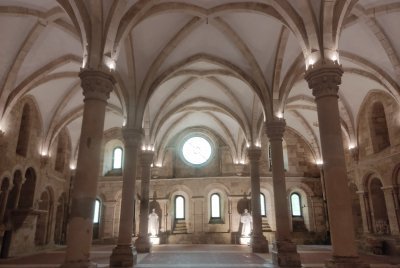
I visited the Alcobaca monastery on oct.the 11th,2024.
I arrived in Alcobaca around 11.45 am and went straight to the tourist office (inside the museum of the speaking machines,free entry,quite interesting) where I could leave my bag till 18.00. Not really necessary as the monastery also has lockers,but I hadnt known this before.
I first entered the church of the Alcobaca monastery (free admission) where the tombs of King Pedro and Lady de Castro are. The church itself is characterized by an elegant simplicity that can only be described as beautiful. I was positively surprised as my expectations for churches are not that high nowadays. I guess I have seen too many in my life. I then went to the cistercian monastery's entrance and started my tour through the unesco heritage place. First the Sala Dos Reis( Kings' room) ...through the Dinis Cloister which gives access to the other main rooms. Then to the Sala do Capitulo,from there to the Common Dormitory on the top floor, from where I could see the tombs of King Pedro and Lady Ines de Castro through a window, that once gave direct access to the church. The refectory is linked to the stunningly large kitchen with its its enormous chimney.From there I went to the upper floor by taking the tight spiral stairs from where I had another astonishing view of the kitchen. From the upper floor you can have a look at another not accessible monastery garden.And dont miss out on …
Keep reading 0 comments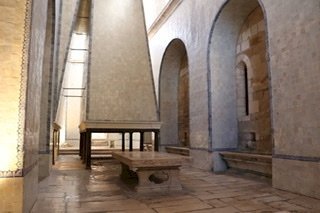
October 2020 - our third and last WHS for that day. Unfortunately parts of it where under construction, so we could not e.g. marvel at the baroque facade. But inside there were many interesting elements again. Sacrophags of Portugals first kings and families. Beautiful fountains in the cloisters visited by numerous white doves. But the most unique part was the tiled kitchen. We originally thought it was something like a hamam for the monks, due to the „bathtubs“ and pool-like tiled construction under the giant chimney. All in all another wonderful monastery which certainly deserves WHS status.
Keep reading 0 comments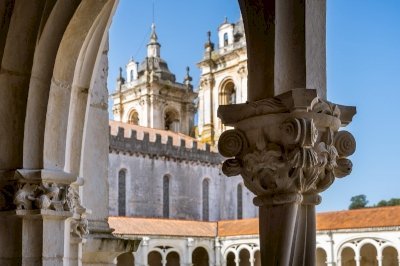
On our itinerary around Portugal in April of 2019 we covered all of the monasteries in the "triangle" north of Lisbon. Alcobaça is the unflashiest of the three, but also clearly the most cared for. The imposing main church façade of Alcobaça is probably the most time-stained part of the complex, whereas everything else bears clear signs of careful upkeep. (Incidentally, putting the word façade next to the monastery name might help those not familiar with diacritics in correctly pronouncing the last consonant in Alcobaça).
The monastery was established in the 12th century by the first king of Portugal, Afonso Henriques. It is primarily a Gothic structure, with some Baroque and Manueline influences added later on. The exuberant Manueline style is widely seen at other monasteries – in comparison, Alcobaça is almost subdued.
The central feature of the complex is the Cloister of Dinis, also known as the Cloister of Silence. At a first glance it may appear no more than pretty and even a bit bland – but that is only until you begin noticing details. Look at the rose windows above the ground-level arches - no two of them are of the same design. Examine the column capitals - they are also all distinct, showing an abundance of fantasy and design. Gargoyles are nothing short of delightful. And so on.
Beyond the cloisters, there are several interior spaces of note, the most impressive of which are the Hall of Kings, with statues of Portuguese monarchs …
Keep reading 0 comments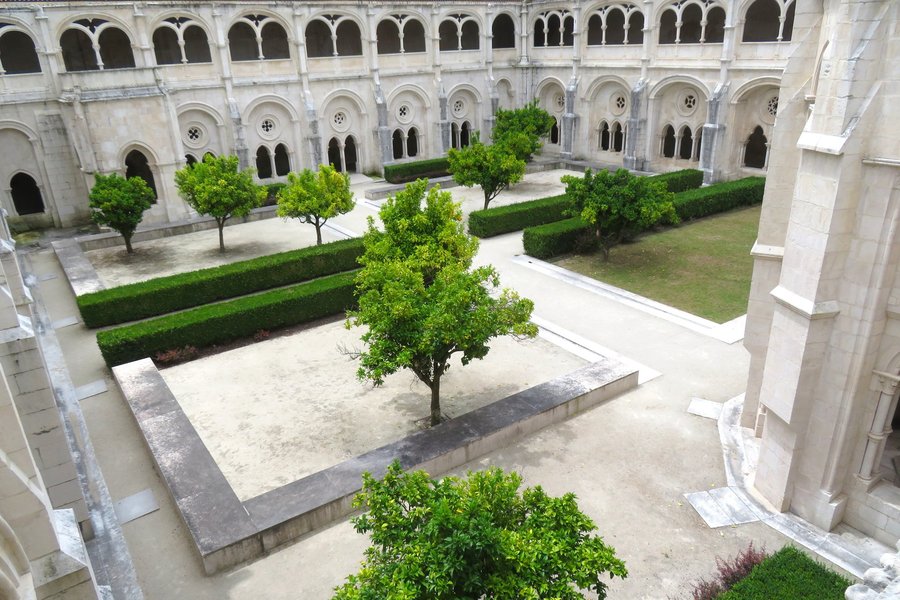
This was the first monastery we visited on our road trip to Coimbra. It certainly was not a disappointment as the day was ideal for these rural small town monasteries. The royal pantheon is noteworthy and the details on these tombs are really superb. These sarcophagi with their stories finely carved on their exteriors are memorable.
There are some unique elements to Alcobaça that stand out. The kitchen (later addition) is so huge that at first I was unsure that was its purpose. The Cloister of Silence is really special, the carvings and statuettes are finely detailed. It was fairly obvious which cloister columns have been repaired. Certain columns looked almost new, while others were heavily weather-worn.
While there are plenty of monasteries on the world heritage list, its so hard to place sites like this on the OUV spectrum. What makes a beautiful and historic monastery more valuable than another? I am certainly wary when considering new nominations that are already over-represented. Yet, Alcobaça was inscribed in 1989 and like many world heritage inscriptions during that first decade its really a worthwhile site to visit.
Keep reading 0 comments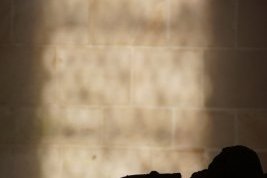
I visited Portugal in May 2018 and Alcobaça was the first of three WHS of the monastery hotspot in the Centro region. I stayed overnight in Alcobaça and was the first and only one at the entrance to the monastery on a Sunday morning at 9 am. At the ticket counter I was recommended to visit the church first, because there would be a mass at 11 am. For about 15 minutes I had this huge nave all to myself, a wonderful atmosphere. The church emanates a simple elegance, there is only little decoration, all in line with the spiritual view of the Cistercian order. The interior is impressive by its size, I was surprised to read that it is the largest Portuguese church. Most striking are the shrines of Inês de Castro (photo) and King Pedro I in the transept. Their tragic love story is very popular in Portugal and inspired numerous works of literature and music. The reliefs on the tomb of Pedro show scenes from their lives. The tomb of Ines is carried by sculptures that are supposed to depict her three murderers.
Only a part of the monastery is open to visitors, mainly the rooms around the oldest cloister, the Claustro de Silencio. Coming from the church, you first enter the Room of the Kings decorated with white-and-blue tiles. Other highlights are the refectory, the chapter house and the monastery kitchen with its huge chimney and a large water basin, part of an elaborated system …
Keep reading 0 comments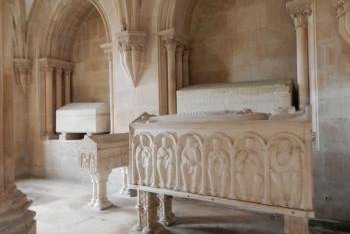
I visited Alcobaca as part of an organized daytrip from Lisbon (together with Batalha, Óbidos, Nazaré and Fatima), so we only had a limited amount of time available there. Basically, we just got a look around the huge main church, but not at the rest of the monastery complex. The church is the largest in Portugal and features the Royal Pantheon where 3 kings of Portugal are buried. The most famous sarcopahagi, and the main reason so many tourists visit the church, are those of King Pedro I. and his mistress Ines who had an ill-fated love story in the 14th century.
Keep reading 0 comments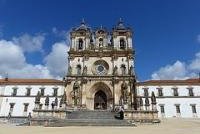
I visited this WHS in August 2014. I spent half a day here after visiting Batalha and on my way to Lisbon. Again the combined ticket I had bought in Tomar turned out to be quite handy although there were less people here than there were in Tomar or Batalha. The highlight of my visit was the recently whitewashed courtyard although on the whole this is the monastery that impressed me the least as a WHS. Perhaps it was just fatigue but apart from being a huge structure with a lovely courtyard I cannot say that I felt it justifies its inscription as it didn't deliver any OUV. Nonetheless it was a pleasant stop on the way to Lisbon.
Keep reading 0 comments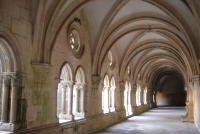
From the lonely train station, I took a taxi to revisit the famous Monastery of Santa Maria of Alcobaça which located almost in the middle of the small town of the same name, Alcobaça. After got information on connecting bus to Batalha from the very friendly tourist information and nice hot chocolate from the lovely café on the monastery square, I was ready to explore the huge monastery again. The first thing I admired was the monastery’s façade and entrance; its perfect proportion with the rest of the complex was really well designed and its lovely sculptures were really supporting the overall ensemble. For interior, at first, I was quite disappointed to the really plainness of the church, but the magnificent tombs of Petro I and his wife, Ines de Castro and their tragic love story colorfully filled the church with romantic theme.
Other highlights were the cloister, the refectory and the monastery kitchen, the cloister was really large with many lovely decorations especially from the second floor, and the fountain hall was one of the best sights of the monastery. The refectory, in my opinion, maybe the most elaborated room of the monastery with many beautiful window channels, and lovely pulpit. The monastery kitchen was quite unique with the really big chimney liked industrial factory. For other parts of the monastery were quite simple with really plain design with some glazed tiles decorated, a very typical Portuguese interior. The tour route inside the monastery was quite well organized and …
Keep reading 0 comments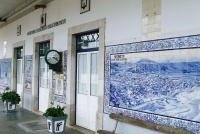
The blue and white tile panels at Alcobaca station are also interesting, depicting scenes from the Holy Land.
The station is at Valado, some distance from the monastery. Connecting buses are available during the week, but at the weekend there are only taxis.
Keep reading 0 comments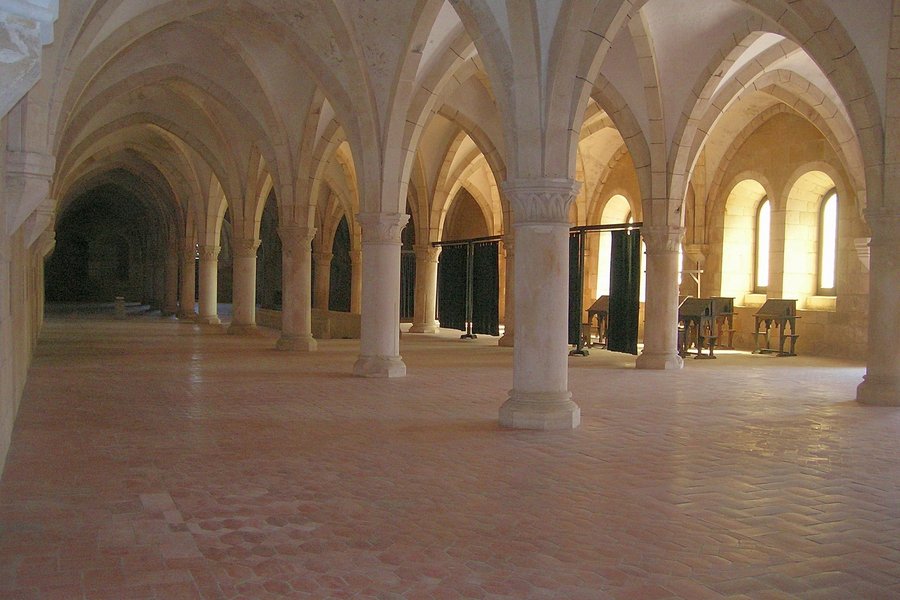
I love the grandeur and simplicity of this place. Reminded me of the design addage "Less is More".
Keep reading 0 comments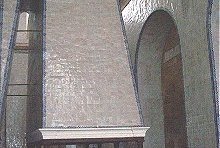
One of my Portuguese favourites, this site is. Two hours by public bus from Lisbon, through continuous rain, took me there.
But the sun started to shine when I arrived in the town of Alcobaça. The Monastery is in the heart of it, so locals are confronted by it every day when they go to the post office or shopping.
While the outside looks massive, the inside is very pretty. I especially lingered in the huge kitchen. This is completely covered with white and blue tiles and has a strangely scaped chimney (see picture above).
Keep reading 0 comments
